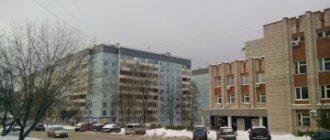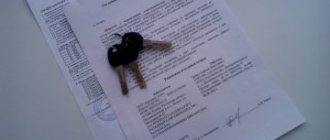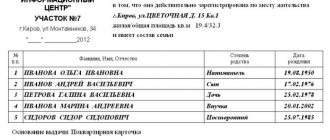Home / Conflict with neighbors / Act on residence or non-residence at the address
For various reasons, the place of registration of citizens does not always coincide with the place of their actual residence. If it is necessary to confirm where exactly a person lives or does not live, a special act is drawn up. In what situations might it be needed? What is needed to draw up a document?
Function of the act of residence/non-residence at the address
An act of residence/non-residence at an address is a document that confirms the actual residence of a citizen at a specific address.
This information is required in the following situations:
- the citizen’s place of residence does not coincide with his actual residence, and there is no registration at the place of residence;
- the apartment is not equipped with individual water meters;
- the apartment is unofficially rented out;
- Migrants live in the apartment without appropriate permission.
Important! The document cannot be used by the management company to recalculate the amount of payment for utilities. But it can be used to submit an application in order to reduce the payment amount.
One of the normative documents that regulate the basis for drawing up an act is. provides for the possibility of preparing a document if the service provider, management company or housing association knows that the number of registered and actually living citizens in the apartment does not match.
Based on the document, recalculation can be carried out. But only if the apartment is not equipped with metering devices or the meters were not checked within the prescribed period.
2 types of acts
Certificate of residence - is drawn up to confirm the fact of residence of a citizen at the specified address and is direct evidence.
An act of non-residence is drawn up to establish the fact that a citizen, for some time, does not reside at the place of registration. And, as a result, he loses the right to own and use the specified living space.
By whom and for what are acts used?
Utility services
When citizens, due to some circumstances, do not live at the place of registration, or, in the area of the living premises there is a large
its number of registered persons, utility services draw up these acts to recalculate payments for services. This is done, more often, in houses where there are no utility meters (electricity, gas, hot and cold water). The document is drawn up and submitted to management companies.
Management companies
Management companies need an act on the number of citizens living in a particular residential area when drawing up utility bills and establishing the real load on the house.
Migration Service
The Migration Service draws up an act in cases where people (foreigners and stateless persons temporarily residing in the country) do not reside at the place of official registration. The document is drawn up and transmitted, if necessary, to other authorities.
Investigative authorities (police)
Acts on residence or non-residence of citizens at the place of registration are used by various authorities. Investigative authorities (police) draw up reports in cases where a case of eviction or illegal rental of premises is pending. And also during investigative activities and, even, during the conduct of some criminal cases. The act is then attached to the case and submitted to the courts.
Creditors and enforcement services
It happens that people, when applying for loans, indicate one address, but live in a different place. If a credit institution has claims regarding payments and if the borrower does not live at the specified address, an act is also drawn up confirming that certain people live at the specified address.
Homeowners
Homeowners need to draw up this kind of paperwork in cases where:
- people registered in the residential area do not pay utilities, and the owner needs compensation for expenses;
- people who do not live in a given territory for some period of time are deregistered and lose ownership of property; there is a need to sell real estate and deregister registered citizens, and the owner does not have information about the whereabouts of any person. The act is drawn up and submitted to the court to issue a resolution on deregistration in absentia at a specific address;
- persons without registration live in the living space for some long period of time. An act is drawn up and submitted to utility services or management companies to recalculate payment for the use of services;
- the owner leases the premises, and the tenants violate the terms of the lease agreement. The document drawn up is a weighty argument in the case of early termination of the lease agreement or compensation for losses incurred;
- there is a risk of illegal registration of unwanted or unknown citizens.
Neighbours
The initiators of filing an application for inspection of a residential premises can be both home owners and neighbors.
Neighbors can initiate an inspection and draw up a report if:
- residents of neighboring premises violate the rules and living conditions (violation of silence, neglect of common property, failure to comply with sanitary and hygienic standards, violation of the law, etc.);
- neighboring residential premises are illegally rented out and the tenants also do not comply with living conditions.
The neighbors draw up an act in compliance with mandatory standards and then submit it to management companies, the police or higher authorities to resolve the situation.
Often, a certificate of residence or non-residence is provided when registering subsidies, social benefits, benefits, medical insurance, and when drawing up legal contracts. It happens that in order to get an education, people are forced to leave their place of registration and move to another city or country. Such acts contribute to a safe relocation and unhindered education.
Rules for drawing up the act
The law does not establish certain conditions for the execution of the document. However, in 2021, the practice of drawing up an act has already developed.
Basic Rules:
- the document is drawn up in writing;
- the form is drawn up by a commission;
- the commission must include the homeowner;
- the commission must include an official (precinct or representative of the management company);
- The commission should include residents of neighboring apartments.
The law does not establish the need for notarization of a document. But if desired, citizens can have the form certified by a notary.
List of persons who have the right to initiate the document execution procedure:
- residents of neighboring apartments;
- district police officer;
- representative of the management company, housing department or HOA employees;
- the citizen himself;
- relatives;
- apartment owner;
- bailiffs.
The commission must include at least 3 residents who legally reside in neighboring apartments.
Features of each option
In general, the procedure for drawing up a document and its contents are the same for each individual case. But it is worth paying attention to the place where the act is submitted. The composition of the commission depends on this:
- Court. If a trial is initiated, each member of the commission must be present. This must be taken into account when assembling committee members.
- Subsidy. To review a paper in a public service organization, a district police officer must be present in the commission.
Sample act
The document is drawn up in handwritten form. The law does not provide for a special form. However, official record keeping forms must be followed.
The certificate of residence/non-residence at the address must include:
- data of the organization for which the document is intended;
- information about the process initiator;
- data of the person whose actual residence/non-residence is being established;
- Title of the document;
- information about the members of the commission (full name, residential address and position of each of them);
- the fact that is being established (residence or non-residence);
- data of the person in respect of whom the fact is established;
- residential postal address;
- period of residence or absence at the specified address;
- signatures of all commission members;
- Date of preparation;
- a note indicating the presence of a citizen at the time of inspection;
- signature of the citizen or information about refusal to sign.
Act of actual residence: form
ACT
establishing actual residence
____________ "______" _______________ 20__
Commission consisting of:
- ____________________________________________
- ____________________________________________
- ____________________________________________
drew up this act stating that when visiting apartment No.____ in house No._____ on the street _______________________, _______________, in which, according to the data of the passport office, the following were registered:
____________________________
____________________________
____________________________
The fact of residence in addition to the registered following persons has been established:
____________________________
____________________________
____________________________
The act was drawn up in the presence of the apartment owner ____________________________
Statements or comments from the owner ____________________________
(_____) signature ______________
____________________________
(_____) signature ______________
____________________________
(_____) signature ______________
Where is it served?
The document is submitted at the place of request. If you need to discharge a person, the act is sent to the passport office; when calculating utility bills, it is sent to the Criminal Code. To evict foreigners from their rented apartment, contact the migration service. In order for a document to be considered, the testimony of witnesses (neighbors) and their signatures are important.
ATTENTION! It is also recommended to sign a representative of the Criminal Code, together with whom the actual place of residence of the citizen is verified.
Who can compose?
The act of actual residence can be drawn up:
- Neighbors;
- By the citizen himself;
- Relatives;
- District police officer;
- Employees of the housing company;
- Representatives of the registration department;
- Bailiffs;
- Housing department workers.
In some cases, a document confirming actual residence in an apartment is drawn up by the lessor or owner of the premises. It is drawn up in writing and compiled manually, but you can use a form in which the necessary data is entered. Registration of the document requires the presence of a commission. If a person refuses to sign the act, this is reflected in the document. The neighbors must sign the document, and the housing and communal services representative also signs.
Who can initiate the preparation
Such a document is drawn up by different persons, usually the initiative comes from someone who is interested in establishing the fact of a person’s actual residence:
- When you need to recalculate utility bills, relatives living in the same living space need the document.
- The document is also initiated by the family if the citizen needs to be discharged from the apartment.
- Neighbors who are dissatisfied with the tenants’ behavior may insist on inspection.
- The district police officer, housing office employees, and representatives of the registration and registration authority are also authorized to draw up this act.
- If it is necessary to remove tenants from the apartment who do not want to voluntarily leave the property, the property owner can also use the capabilities of this document.
A commission is assembled to draw up the act . The person whose registration is in question must also sign. In the case when he refuses to sign the document, evidence from neighbors in the apartment and representatives of the Criminal Code is sufficient.
Procedure for drawing up the document
The document is drawn up exclusively in the presence of the commission, it includes:
- Neighbours;
- District;
- Housing and communal services employees.
The legislation does not provide a clear form for this paper, so the act is written in free form. The execution of the document requires the presence of the owner, and an inspection must be carried out to confirm the applicant’s words.
The act of actual residence in the residential premises must include the place of registration and evidence of the information contained in the paper. Those present must sign, then the paper is transferred to its destination: to the management company, to the investigative committee, to the court, etc.
If possible, the initiator of the act must attach papers and certificates of the citizen’s actual place of residence.
If you need to confirm the fact of residence of a citizen, you must go to court. The application is submitted at the place of residence of the originator. You must pay the fee and ensure that witnesses come to the courtroom. Usually it is the neighbors who act as witnesses. It doesn’t matter where you submit the document; it is always certified by the Housing Office or the management company.
First, a citizen must go to the housing office and get a certificate of family composition. Then he draws up an application and draws up a document, supplementing it with some documents or copies.
How to draw up an act of actual residence in an apartment?
First of all, if you need to draw up an act of actual residence, no one will provide you with an official sample. The paper is drawn up in a more or less random order, but must contain the following information:
- date of document preparation;
- the address at which the check was carried out and where the fact of residence was established;
- passport details of the person whose residence is established in the apartment;
- evidence confirming the fact of residence or non-residence in the apartment;
- place of residence (registration) of the person, if any;
- data from witnesses to the document;
- signatures of those making the document and witnesses.
It is worth paying attention to the fact that the act of residence is drawn up by a commission, and not by one person. If the document was drawn up with violations, this is a reason for lawyers to challenge the validity of the paper, and for the court not to take this act into account.
The commission may include:
- neighbours;
- district police officer;
- representative of the management company;
- other persons.
In the process of drawing up an act of residence, the apartment is inspected by a commission in order to find the belongings of the person whose residence here must be proven. The drawn up document is checked by members of the commission, after which they sign it.
Who draws up the document?
The initiator of the document is usually the owner of the property. But the actual preparation of the paper will be done by:
- housing department employee, representative of the management company, public utility service;
- bailiff;
- district police officer;
- law enforcement representative;
- neighbors living nearby.
The owner draws up the paper only in front of witnesses. These may include any of the listed persons.
Another important rule is that one person cannot draw up a deed. Typically, a group of interested parties gathers. This could be neighbors, a police officer, a local police officer or other citizens. The main thing is that the number of people is more than three.
There are only two situations in which a citizen can independently draw up a document - without witnesses and on his own behalf. We are talking about the act of non-residence. That is, the person himself confirms the fact that he is not at the established address.
You can also draw up a document yourself in a situation where a citizen becomes aware that a fraudulent act has been drawn up, for example, for the purpose of forced eviction. He can write his act, thereby officially confirming his residence.
Who can draw up this document
The owner himself has the right to draw up an act (if he needs a recalculation of utilities or intends to rent out the premises).
In case of official need, it can be drawn up by representatives of the authorized bodies listed in the previous paragraph - representatives of the migration service, district inspector, bailiffs, housing office employees.
It happens that the act is drawn up by neighbors. We will discuss this option in a separate paragraph.
In order for the document to have legal force, it is necessary to draw up a commission. The commission usually includes neighbors, housing office workers, police officers or a local inspector. One representative from each body. They jointly draw up a deed and sign it.
Certificate of residence, form
You can write it manually or fill out a ready-made form.
No special form of the document is fixed anywhere, but it, like all official documents, is subject to generally accepted requirements:
- details (last name, first name, patronymic, registration or actual location address) of the applicants and the person being inspected;
- information confirming or refuting the residence of the person being inspected in this territory;
- evidence (if available);
- data of commission members;
- signatures of all those present.
If the owner refuses to sign, this is noted in a separate column.
You can attach data from a survey of witnesses, who are neighbors.
How to write an act of residence from neighbors, features of drafting
If the owner illegally rents out an apartment, and the tenants disturb the silence or do not comply with sanitary and hygienic standards, neighbors can draw up a certificate of occupancy.
The emphasis should be on the fact that the owner of the apartment himself does not live in it. You can contact the Housing Office. There they will confirm the fact of non-residence of the owner and issue a corresponding certificate.
You can now contact the police with these documents. And they will continue to act in accordance with the law.
Cohabitation Act
A specially created commission records the place of residence of the person being inspected.
The act contains the following information:
- date, address;
- Full name and personal data of the person being verified;
- evidence confirming the constant presence of a person in the inspected residential premises;
- current place of residence (if relevant information is available);
- Full name and personal data of persons included in the commission;
- date, signatures of participants.
Attention! Our qualified lawyers will assist you free of charge and around the clock on any issues. Find out more here.
The neighbors draw up an act containing the following information:
- Full name and personal information of neighbors;
- information about the person being checked;
- date, signatures.
The drawn up act is signed by the district police officer or a representative of the management company.
There is no special form provided for the act; free presentation of the text is allowed.
ATTENTION! View the completed sample deed of cohabitation:
Advantages
If, on the basis of the document, a citizen is discharged from the apartment, he will lose his rights to real estate:
- A certificate about those actually living in the apartment is needed to evict a person who has been living in another place for a long time and does not want to leave
- Neighbors can get rid of careless tenants who are living in a rented apartment illegally and who are disturbing the order.
- You can save on utility bills if, when calculating them, you use the number of residents actually living in the living space, and not those formally registered.
- One of the parents can use this certificate to demand child support. The act of cohabitation of only one parent with a child will be an important argument for the court.
- An act of living together may be required for kindergarten or school.
Rules for drawing up a document
The apartment owner and neighbors have the right to initiate the drafting procedure. It is compiled by employees of the management company.
The following requirements for the procedure are presented:
- Only a written form of the act is acceptable;
- the act itself is drawn up manually;
- the presence of the commission is mandatory;
- the presence of the apartment owner is required during its inspection;
- the text includes testimony from persons who participated in the inspection;
- an application is drawn up, which includes documents that are relevant to the case;
- if a person refuses to sign the act, this is noted in the text.
Signatures are provided by witnesses, as well as a representative of the housing and communal services.
Where can I complain about my neighbors illegally renting out an apartment?
Is it possible to install a camera in the entrance without the consent of the neighbors? Read here.
If the management company employees are not going to certify the document and are deliberately delaying time, contact your neighbors so that they can witness the inspection procedure. A notary also has the right to certify the deed.
ATTENTION! Look at the completed sample act of actual residence of citizens:
What to remember
In order for this document to be reviewed by the relevant authorities and have the expected effect, you should not forget about the data that must be on the paper. Despite the fact that there is no single template for such a document, without some information it will be considered invalid:
- Be sure to write the name “Act”.
- There must be not only the neighbors’ signatures, but also their passport details.
- The address of the apartment is indicated.
- It is important to write whether the citizen lives or does not live in the specified living space.
- The act must be signed and the date of its preparation must be indicated.
Regardless of where the paper is submitted, it is certified either by a representative of the management company or by a local police officer.
ATTENTION! If such an act is drawn up by representatives of the investigative body, administrative, an additional inspection report of the premises is also drawn up.
Advantages of this act
The purpose of drawing up the act is to establish the legal order of residence. The document helps speed up the re-registration procedure.
The act has the following advantages:
- the person who was discharged loses the rights to the corresponding share of the property;
- helps evict neighbors in case of illegal rental of residential premises;
- promotes the deregistration of a person living at a different address, but refuses to be deregistered voluntarily;
- contributes to reimbursement from the state of expenses for payment of utility bills.
The amount of the subsidy is affected by the number of persons registered in the apartment. The amount of money is inversely related to the income of registered persons.
When drawing up the act, the economic situation of the family is taken into account. It is sent to the appropriate commission, which operates in the executive committee of the local administration, and after reviewing the act, a decision is made.
Act of residence from neighbors: form
Act
about the actual residence of citizens
g. __________ “___”________ ____ g.
Commission consisting of: ____________________________
(Full name, position or residential address)
carried out an inspection of the residential premises ________ at the address: ______________.
As a result of the survey, it was established that the following people live in the residential premises:
1) ________________________________________, (full name, year of birth) registered at this address since ___________;
2) _______________________________________, (full name, year of birth) registered at this address since ___________;
3) _____________________________________, (full name, year of birth) registered at the address _______________ since ___________ (not registered at this address).
Signatures of the commission members:
_____________________
_____________________
_____________________
The procedure for drawing up the act
When registering, you must adhere to the following sequence of actions:
- Decide on the composition of the commission. For this purpose, it is necessary to interview neighbors about their consent to participate in such a procedure, and, if necessary, to additionally confirm their testimony.
- Conduct an inspection of the residential premises at the agreed time to establish the fact of residence or non-residence.
- Record the results of the inspection in writing.
- Sign to all members of the commission. The document acquires legal force immediately after signing by all persons present.
If the commission includes neighbors, you need to make sure that they use the housing legally and live at their current address for at least the period of time specified in the Act.
The inspection of the residential premises and the subsequent drawing up of the document must take place in the presence of the owner of the property or his legal representative, acting in accordance with a notarized power of attorney. During the inspection, the presence of the citizen’s personal belongings is determined, in relation to which the fact of residence needs to be confirmed or denied, and other signs that may indicate the number of residents (for example, the number of beds, the number of cutlery). The following may be used as additional evidence:
- certificates with a period of more than 5 days about work trips, hospital treatment;
- invoices from hotels indicating check-in and check-out dates;
- official certificate of another place of registration issued by law enforcement agencies;
- facts of contacting medical institutions, management companies, housing departments serving the specified address;
- payment documents confirming the division of costs for maintaining the property.
What information does it contain?
The current legislation does not provide for a single model of the Act. It can be compiled in free form with the obligatory indication of the following information:
- Name;
- date and place of registration;
- composition of the commission members (full name, residential address);
- full address of the apartment;
- information about the initiator of the procedure;
- information about the residence or non-residence of the citizen in relation to whom the procedure was initiated, including the date from which the specified event lasts and evidence confirming it (for example, the presence/absence of personal belongings in the apartment);
- statement about the actual location of the tenant or the absence of this information (for the Non-Residence Act);
- signatures of those present.
If the owner refuses to sign, a corresponding note is made in a separate column. Additional evidence of the information specified in the document can be obtained from interviews with witnesses. If available, it is recommended that all available materials be attached to the Act.
The document is submitted at the place of request: when calculating utility bills - to the Management Company, when forced deportation - to the court, when evicting foreign tenants - to the migration service, etc.
Features of individual options
The general procedure for execution and content of the document are the same for all cases. But depending on where it is supplied, a number of points should be taken into account:
- For the court. At the relevant trial, all named members of the commission will be required to be present to testify, so when selecting applicants, this possibility should be assessed in advance for each of them. The refusal of one of the drafters will cast doubt on the authenticity of the Act.
- To apply for a subsidy. In order for the document to be reviewed by the authorized bodies without any problems, it is recommended to involve a district police officer in its preparation.
Main purpose of paper
One of the main purposes of the document is to recalculate the amount of payment for utility services. But in reality, there are quite a lot of situations when a document may be required. Here are the most basic of them:
- Forced discharge of a tenant. If he does not have the right to an apartment, has moved, but remains registered, he can be discharged through the court. This is especially true for a situation where the fact of his registration affects the amount of utilities and general house maintenance. A properly drafted act will need to be attached to the claim.
- Receiving a subsidy. If there are modern individual metering devices, you need to draw up a report to confirm the number of people living in the premises. The paper will confirm who lives in a certain apartment, consumes resources and receives a certain income, and who does not. Based on this information, the subsidy amount will be calculated.
- Termination of the lease agreement. If a person rented housing under a contract, but moved out earlier than the deadline and does not pay rent, the act will help terminate the contract through legal proceedings.
- Creditors and collectors. Fraudsters often indicate the wrong address when concluding a loan agreement. Creditors begin to look for the debtor at the address where he is not. The act of recalculation of utility bills will help prove this fact. In the absence of metering devices, services are calculated for everyone registered. To reduce the amount of payment, you can draw up an official act of non-residence.
Along with the listed situations, the act may be required by the owner in the following cases:
- registration of state benefits and benefits;
- concluding a loan or certain legal agreement;
- obtaining education in order to work later in the tax service or perform other actions there.
These are all common situations. To understand when a document may be required, it is worth considering several specific examples.
How does an act differ from a certificate?
An act of non-residence at the place of registration can be drawn up by employees of the Homeowners Association, Management Company, Housing and Communal Services, bailiffs, passport office specialists or local police officers. The commission must be formed of at least three people.
The document is prepared in the presence of the owner of the premises or his legal representative. A form is filled out based on information obtained during a survey of neighbors. Current legislation gives the right to draw up such an act to private individuals.
These could be landlords, property owners, neighbors. Such a document is often called a certificate.
To draw up an act, other documents may be required confirming the citizen’s non-residence in a specific apartment:
- certificate of temporary registration of a person at another address. It is issued at the Main Department of Migration Affairs of the Ministry of Internal Affairs, the passport office. You can also submit a request to receive it at the Multifunctional Center. Such a document confirms that the person does not currently live at the old place of registration;
- a certificate from the place of work confirming the fact of working and living in another area.
How to write correctly?
The act of non-residence of a citizen at a specific address does not have a standard form. Therefore, such a document is usually drawn up in any form. The act must be in writing and comply with all norms of the current legislation of the Russian Federation.
The document is required to reflect the following information:
- Name;
- composition of the commission. Information about its members is indicated. If the composition includes representatives of housing and communal services, management companies, then their full names, positions, and place of work are written. When the act is drawn up by neighbors, owners of the premises, the surnames, first names, patronymics, passport details and residential addresses of these persons are given;
- Full name of the citizen for whom the act is drawn up. Information that he does not live at a specific address. It is necessary to indicate the date from which none of the residents met the neighbor (as a rule, only the month and year are indicated). A note is also made about whether any of those present are aware of the citizen’s new place of residence;
- the address at which the person is registered but does not live;
- Full name of the owner of the premises;
- a list of documents that are attached to the act and are related to the problem;
- date, time and place of document preparation;
- signatures of all commission members with transcript.
Additionally, you can note the fact that the premises were inspected and the citizen’s personal belongings were not found.
An act of non-residence at a specific address is drawn up in at least 4-5 copies: for each member of the commission, for the regulatory body and the court.
What is a non-residence act, samples
Such an act is drawn up to transmit information to various authorities with confirmation that the citizen lives in a place other than registration.
Most often it is used in judicial practice. And also for processing benefits and solving other serious matters. Example: A citizen registered at one address, but actually living differently, does not pay for housing and communal services. In this case, the property owner has the right to apply to the court with a claim for the forced eviction of the registered defaulter. In this case, the possibility of entering incorrect data in the act should be excluded.
Non-Residence Act – what is it?
Certificate of non-residence (certificate of non-residence) is a document confirming the fact that a citizen resides at a location other than the address specified in the registration.
A certificate of non-residence is required if:
- Notice of unilateral termination of a contract: how to write a letter, sample 2021
- Caring for an elderly person: how to apply, what kind of care allowance is paid
- Federal Law “On the Status of Judges”: 2021 edition
- Notice of termination of lease agreement: sample 2021
- Pension point value in 2021 and what they mean
- Pregnancy certificate: what it looks like in 2021
- Agreement on compensation by transfer of property: sample 2021
- A citizen refuses to be discharged from a living space where he has not lived for a long time (for example, a son has moved out, but wants to retain the right to use his mother’s residential property);
- The landlord terminates the lease agreement with unscrupulous tenants whose location cannot be determined;
- The owner decided to reduce the cost of utility bills that the subject does not pay;
- The tenant wants to document that another citizen is not using the apartment (also termination of the contract);
- Residents need to confirm the non-residence of the citizen who is being sought by collection agencies;
- Residents need to confirm the non-residence of the citizen who is wanted by the bailiffs.
Why register information about residents?
A certificate issued by the initiator allows you to establish the legality of use of residential premises. In addition, paper helps speed up the re-registration procedure. Also, with the help of the act, you can evict citizens if they illegally rent an apartment and systematically cause inconvenience to their neighbors. A person discharged in accordance with the procedure established by law and who had the right to part of the housing loses the latter. The document generated based on the results of the audit facilitates the task of deregistering a person who actually lives in another place and refuses to be deregistered voluntarily.
In some situations, fierce disputes arise between residents and housing and communal services structures. Obtaining the documentation discussed in this article will allow homeowners to receive compensation from structures that charge fees for housing and communal services in the event of overpayment, as well as obtain appropriate benefits. In the latter case, the number of persons permanently staying in the housing directly affects the amount of the benefit provided to the owner.
Important! Drawing up an act is associated with one more feature. We are talking about taking into account the financial situation of the family living in the apartment. The information is sent to a commission working under the executive committee of the municipal administration. Upon completion of the information review procedure, an appropriate decision is made.
Question:
What is meant by actual place of residence and why might such information be needed?
Answer:
The place of actual residence refers to the real estate used by a person. However, the presence of registration at the address does not affect this rule in any way. The certificate is used to calculate amounts for utility bills, as well as to resolve disputes that arise with migration registration authorities. The document must contain comprehensive information about the citizen in respect of whom the act is being drawn up.
Liability that threatens in case of violations
Persons located (residing) in the Russian Federation are required to obtain at least temporary registration. The standard period provided for the implementation of relevant actions is 3 months. After this period, the person receives a fine. A similar sanction is applied when visiting an authorized body after the end of the period.
The fact of illegal presence at another address is difficult to establish in practice. However, if relevant facts are identified, Art. 19.15.1 Code of Administrative Offenses of the Russian Federation. This article presupposes a sanction in the form of an administrative fine in the amount of 2 to 3 thousand rubles.
The amount of fees for committing an offense is also established at the regional level. So, if the violation was committed in the capital or St. Petersburg, the fine will be from 5 to 7 thousand rubles. Penalty can be avoided under the following circumstances:
- the citizen has a residence permit and actually resides within the same municipality;
- temporary registration of family members of a citizen registered at the address is not required;
- persons renting rooms in dormitories are registered in the same region.
A fine can be avoided by following one rule. You must appear regularly at the place of registration. Then the neighbors will know that the housing is not for rent and has not been abandoned by a person for the purpose of living in another place. However, if there are suspicions, residents of neighboring apartments can initiate eviction proceedings. Such cases are more often associated with the illegal rental of housing to noisy companies or to persons suffering from alcohol and drug addiction. Relatives are evicted within 12 months, and foreign nationals - within six months.
Accommodation without registration
Neighbors can call a commission to determine the legality of residence of certain persons in a rented apartment. If the tenants do not have temporary registration at the specified address, the commission determines how long they have been living here and whether the migration regime has been violated.
When arriving in the country from abroad or when moving to another city for work or study, you should take care of temporary registration. It is issued for 90 days only. If during the inspection it turns out that the person does not have temporary registration at the specified address or its period has already expired, the culprit will need to pay a fine.
The punishment complies with the norms of Article 19.15.1 of the Code of Administrative Offenses of the Russian Federation, which considers living at the place of stay or residence without registration. The fine amount is 2000-3000 rubles. In Moscow or St. Petersburg you will need to pay up to 7,000 rubles.
Temporary registration is not needed for those who actually live at a different address, but within the city, who live with relatives, who live in a rented apartment and have a residence permit in the same locality.
Changes in legislation
Until 2013, acts of actual residence were the basis (along with other documents) for neighbors or housing department officials to independently identify defaulters for whom additional utility bills were charged. However, after changes in legislation, upon identification of illegal residents of an apartment or house, it is possible to draw up a protocol on violation of administrative rights.
What legal force does the document have? Based on further consideration, payments may be recalculated. No other documents provide grounds for recalculating receipts for utility services.
Sources
- https://allo-urist.com/akt-o-prozhivanii-ili-neprozhivanii-po-adresu/
- https://o-nedvizhke.ru/dokumenty/akty/akt-o-fakticheskom-prozhivanii.html
- https://ahrfn.com/vyselenie/akt-o-fakticheskom-prozhivanii-ot-sosedej-obrazec.html
- https://kakoepravo.ru/zhilischnoe-pravo/akt-o-fakticheskom-prozhivanii.html
- https://yurzona.ru/sosedi/akt-o-prozhivanii-po-adresu-podtverzhdennyj-sosedyami-kak-ego-sostavit-obrazets-i-pravila.html
- https://potreb-prava.com/nedvizhimoe-imushhestvo/zhilaya-nedvizhimost/obrazec-akta-o-prozhivanii.html
- https://o-nedvizhke.ru/dokumenty/akty/akt-o-prozhivanii-ot-sosedej-obrazec.html
- https://law-divorce.ru/akt-o-prozhivanii-ili-neprozhivanii-po-adresu/
- https://prozakon.guru/nedvizhimost/obrazczy-i-akty/o-neprozhivanii-po-adresu-podtverzhdennyj-sosedyami.html
- https://semyahelp.ru/zhilishchnoe-pravo/kvartirnyj-vopros/kak-oformit-akt-o-fakticheskom-prozhivanii-v-kvartire
- https://FininRu.com/chto-eto-takoe/akt-o-sovmestnom-prozhivanii











